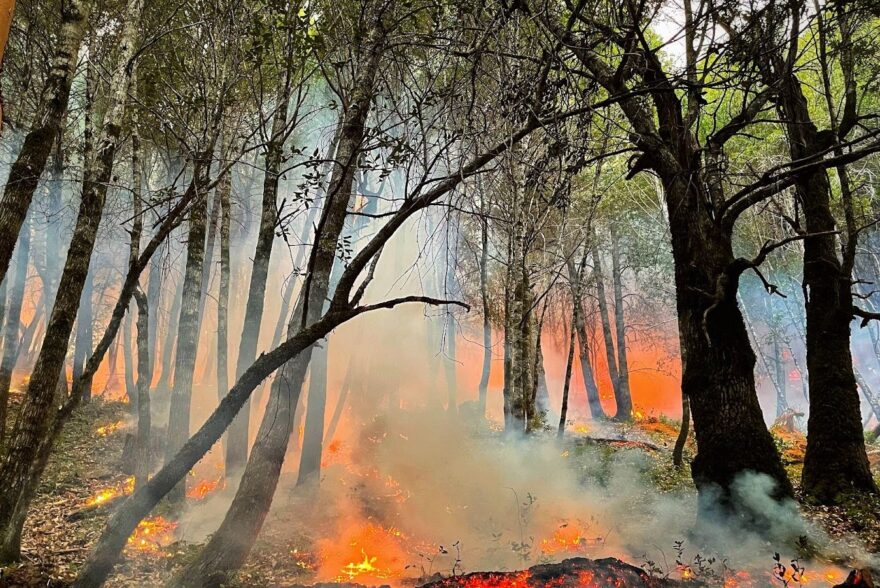Bridging Fire Knowledge: Integrating Indigenous Stewardship and Western Science for Resilient Land Management


For at least 10,000 years, Indigenous land stewards have used fire to proactively steward and shape landscapes and cultural resources. Yet, finding literature and informed ecosystem modeling that incorporates the historical use of fire proves to be a significant challenge.
Written by: Robyn Brooks, Project Associate
Western society has followed the general belief that fire is ‘bad’ and doesn’t belong on the landscape. This has shadowed us for the last century, as we suppressed fires and outlawed Indigenous cultural burning to ‘protect’ landscapes, leading to the destructive fire behavior we see today. It has taken many devastating fires to occur before true paradigm shifts have started to take hold through proactive land restoration. As Western science begins to understand and recognize cultural burning and Indigenous land stewardship strategies, modeling, and other scientific tools often lack the historical data needed to accurately project the extent of human management best suited for a landscape.
To address this challenge, Skye Greenler, who at the time was a PhD student at Oregon State University, partnered with the Karuk Tribe Department of Natural Resources. Their objective: to develop simulations of cultural ignitions and burning patterns across the Karuk Aboriginal Territory to demonstrate traditional stewardship practices in a paper titled Blending Indigenous and western science: Quantifying cultural burn impacts in Karuk Aboriginal Territory. Greenler sought to center Karuk voices throughout the research by cross-referencing data with Tribal knowledge, ultimately using the data that came closest to the Indigenous sources. As Greenler says, “One of the strongest sources of information is the people who lived on and stewarded those landscapes for millennia and their descendants who hold that knowledge.”
In a conversation with Greenler and Paul Hessburg, a Blue Forest science advisor and co-author on this paper, we explored the challenges in integrating Indigenous knowledge into scientific research. One of the most prominent limitations to bridging the gap between Western science and Indigenous knowledge is effectively and ethically collecting and analyzing data. Indigenous knowledge is largely passed down in narrative form through storytelling, songs and chants, dances and sacred rites, which is often not recognized by Western science as legitimate data. Additionally, western management practices have historically fostered an extractive and harmful relationship with Indigenous communities.
For this paper, researchers utilized a Pikyav agreement, a framework for researchers to build long-lasting and respectful relationships with their tribal partners. The Pikyav agreement was created by both UC Berkeley and the Karuk Tribe to guide how the research will be conducted, reviewed, and knowledge safeguarded, fostering long-term supportive relationships between researchers and tribes. “You move at the speed of relationships and trust,” Hessburg explained when discussing the knowledge transfer and relationship building that happened throughout this research. To foster meaningful and lasting relationships with Indigenous Peoples, it is essential for Western scientists to respect cultural norms and timelines. This approach may require us to slow down initially, but it ultimately allows us to cover more ground by establishing trust and collaboration with partners.
Blue Forest is working to develop meaningful relationships with Indigenous partners across the Western U.S. as we work to accelerate forest restoration through Western science and Indigenous knowledge. My colleague, Saraya Hamidi, had a chance to speak with Bill Tripp, co-author and Director of Natural Resources and Environmental Policy for the Karuk Tribe, Department of Natural Resources. “Indigenous means ‘natural to place.’” He said. “This paper helps to demonstrate, through data, that our indigenous fire use practices have been natural to this landscape for millennia.”
The collaboration between the Karuk Tribe and Greenler demonstrates the significance of cultural burning on fire patterns across northern California. Traditionally, nearly 7,000 annual cultural ignitions occurred across the 264,399-ha study area, providing consistent land stewardship that altered vegetation near villages and trails to sustain cultural resources such as food and medicine. The resulting simulations aligned well with reconstructions of historical fire behavior and reaffirmed that Indigenous fire stewardship was integral in shaping historic fire patterns and vegetation conditions. By demonstrating the impact of Indigenous land stewardship on resilient ecosystems, the authors prompt Western science to incorporate Indigenous cultural practices into contemporary management decisions and reduce barriers to stewardship with cultural fire.
Photo courtesy of Skye Greenler.